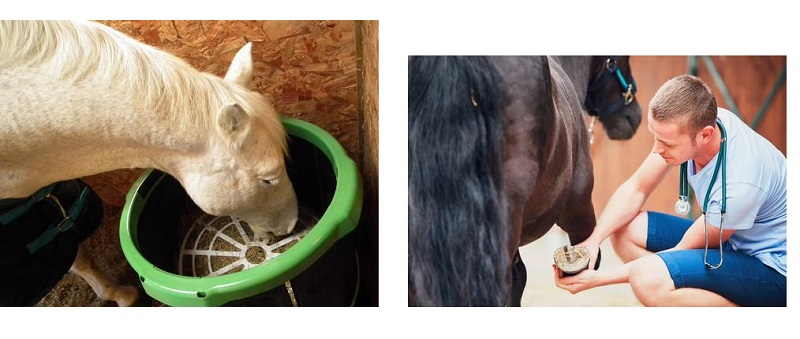Posted: 1st November 2018 | Back to news feed

Haygain examine what laminitis is, what causes it and how to spot it in your horse or pony
Laminitis is a crippling condition that affects horses and ponies around the world, attacking the integrity, strength and function of their hooves. It strikes fear into their owners and is taken extremely seriously by vets and farriers alike, because, if it is left untreated, laminitis can become untreatable and necessitate the euthanasia of the horse. Haygain, who are known for their innovative equine health products, explore what laminitis is, how to spot it and what causes the condition to occur.
What is laminitis?
Laminitis occurs in a horse’s hoof and results from disruption of blood flow to the laminae, sensitive Velcro-like tissue which secures the coffin bone (also known as the pedal bone and the last bone at the very bottom of the horse’s leg) to the hoof wall. This weakened connection allows the coffin bone to rotate and sink, and in the very worst cases penetrate the sole of the horse. If this most extreme point the horse’s health, comfort and ability to function are so severely compromised that euthanasia is the only humane option left to the owner and veterinarian.
If laminitis is spotted and diagnosed quickly, ongoing treatment and management may be able to keep the condition at bay and enable the horse to live a healthy pain-free life, so let’s take a look at the signs to look out for.

What are the signs of laminitis?
Assess the risk of your horse developing laminitis by examining their hooves carefully, as raised ridges can indicate a previous episode of laminitis. Another early warning sign of the potential for laminitis is obesity, as horses who are overweight or put weight on very easily are at greater risk of the condition than the wider horse population. If you’re not sure if your horse is overweight or not, run your fingers lightly but firmly from front to back across their barrel. You should be able to feel the ribs without having to press hard, but not see them. If you have to press very hard to feel the ribs, then the horse is overweight.
But what are the signs that your horse or pony has laminitis? At the very early stages a horse with the condition may be unwilling to walk forward, but this is such a subtle indicator and so easily influenced by other factors that it goes unnoticed. The front feet of the horse are affected most by laminitis because this is where a greater proportion of the animal’s body weight is borne. They may lie down more frequently to take the pressure off their feet, and the classic backward-leaning stance will be seen as they attempt to relieve the painful pressure on their front feet.
If you take the digital pulse of a horse suffering from laminitis then you will feel it ‘bounding’, and the hoof will feel warmer than normal to the touch. If hoof testers are used to put pressure on the sole to test for sensitivity associated with laminitis.
What causes laminitis?
Laminitis is a symptom of other problems in the horse rather than a standalone condition, so the causes are quite diverse, from nutritional or exercise management triggers to hormonal or genetic conditions.
One of the most common and best-known triggers is sudden over-grazing, particularly on new grass growth. New grass has a high sugar content (which is higher again in the morning and late at night) so if a horse isn’t usually turned out much, or your grazing suddenly goes mad in the spring, ensure turnout is limited while the animal’s digestive system adjusts. Abrupt changes in any feed will increase the risk of laminitis, so for example if you need to change from hay to haylage, or mix to pelleted feed, then ensure it is gradual.
As previously mentioned here, obesity puts equines at a higher risk of laminitis than those of a healthy weight, so ensure you monitor the condition of any horses in your care, particularly if their exercise regime changes for any reason. Sudden unexplained weight gain may be caused by metabolic disorders such as Thyroid Dysfunction (TD), Equine Metabolic Syndrome, Equine Cushing’s Disease or Pituitary Pars Intermedia Dysfunction (PPID), all of which mean the horse concerned is at a greater risk of laminitis.
There are a number of less common causes which are also worth knowing about, including ‘road founder’ which is when too much work on hard or uneven surfaces causes laminitis to occur. This is seen less frequently now that horses are used for pleasure more than work and therefore are not required to work all day on roads and tracks. Supporting limb laminitis is sometimes seen when a horse is recovering from a serious injury in one leg, and laminitis then occurs in a different leg which is bearing more weight than it normally is.
Haygain design and manufacture a range of products that help horse owners manage the risk of laminitis, from the Haygain Forager, designed to mimic the natural grazing patterns of a horse but with hay or haylage and which can slow down a greedy eater, to the Haygain Steamer range. Steaming hay can help to remove water-soluble carbohydrates meaning that hay can be fed ad-lib to horses at risk of metabolic disorders. Browse these products and the whole Haygain range here: https://haygain.co.uk/#
The Equestrian Index newsfeed is compiled from articles submitted by advertising members and expresses the opinions of those members. Watsons Directories Ltd shall not be held liable for any inaccuracies or mis-statements therein.
